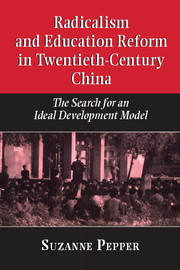Book contents
- Frontmatter
- Contents
- Acknowledgments
- 1 Educational development and the Chinese experience
- Part I The republican era: origins of radical education reform
- Part II Learning from the Soviet Union
- Part III Cultural revolution and radical education reform
- 11 On Stalin, Khrushchev, and the origins of cultural revolution
- 12 The great leap in education
- 13 A system divided: walking on two legs into the 1960s
- 14 Education reform as the catalyst for cultural revolution and class struggle: the 1966–1968 mobilization phase
- 15 Education reform as the culmination of class struggle: the professional educator's perspective
- 16 Education reform as the culmination of class struggle: the critical ideals triumphant at last
- 17 The Cultural Revolution negated
- 18 The mixed triumph of regularity
- 19 Chinese radicalism and education development
- Appendix: the Hong Kong interviews
- Select bibliography
- Index
13 - A system divided: walking on two legs into the 1960s
Published online by Cambridge University Press: 04 August 2010
- Frontmatter
- Contents
- Acknowledgments
- 1 Educational development and the Chinese experience
- Part I The republican era: origins of radical education reform
- Part II Learning from the Soviet Union
- Part III Cultural revolution and radical education reform
- 11 On Stalin, Khrushchev, and the origins of cultural revolution
- 12 The great leap in education
- 13 A system divided: walking on two legs into the 1960s
- 14 Education reform as the catalyst for cultural revolution and class struggle: the 1966–1968 mobilization phase
- 15 Education reform as the culmination of class struggle: the professional educator's perspective
- 16 Education reform as the culmination of class struggle: the critical ideals triumphant at last
- 17 The Cultural Revolution negated
- 18 The mixed triumph of regularity
- 19 Chinese radicalism and education development
- Appendix: the Hong Kong interviews
- Select bibliography
- Index
Summary
The verdict of history might excuse both Mao and Liu for failing to anticipate the consequences of their two-legs/two-systems strategies, because China's educational development was heading into the uncharted territory of mass elementary and secondary schooling with no real precedents for guidance. And even had anyone been inclined to heed the arcane advice of colonial development experts, Philip Foster's formulation of the parity principle at work in Africa had yet to be published, much less assessed against any Asian experience.
Tables 12.1 and 12.2 summarize the essence of the story. What failed was not the Great Leap education strategy but only its irregular work-study component. By contrast, regularity thrived. It emerged triumphant yet again, but with some important differences which finally transformed China's modern school system into one with a permanent mass base. Those differences began in turn to redefine the nature of both regular education and its irregular alternatives.
We will return to elementary schooling in chapter 16, which indicates a continuity of growth from 1958 through the 1966–1976 decade. By the early 1960s, universal elementary education had been basically achieved in urban areas, albeit with an assist from the minban formula at that time. But how to do the same for the rural majority was the ultimate challenge, pursued most systematically during the 1966–1976 years.
Higher education had been the centerpiece of educational development throughout the 1950s and remained in a holding pattern thereafter. The Sino- Soviet compromise model that evolved during the FFYP remained essentially unchanged while Great Leap quantitative increases were absorbed.
- Type
- Chapter
- Information
- Radicalism and Education Reform in 20th-Century ChinaThe Search for an Ideal Development Model, pp. 302 - 351Publisher: Cambridge University PressPrint publication year: 1996



